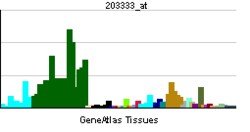KIFAP3
Kinesin-associated protein 3 is a protein that in humans is encoded by the KIFAP3 (also known as KAP3) gene.[1][2] It is a non-motor, accessory subunit which co-oligomerizes with the motor subunits KIF3A and KIF3B or KIF3C, to form heterotrimeric kinesin-2 motor proteins. Kinesin-2 KAP subunits were initially characterized in echinoderms and mice.[3][4]
Function
The small G protein GDP dissociation stimulator (smg GDS) is a regulator protein having two activities on a group of small G proteins including the Rho and Rap1 family members and Ki-Ras; one is to stimulate their GDP/GTP exchange reactions, and the other is to inhibit their interactions with membranes. The protein encoded by this gene contains 9 Armadillo repeats and interacts with the smg GDS protein through these repeats. This protein, which is highly concentrated around the endoplasmic reticulum, is phosphorylated by v-src , and this phosphorylation reduces the affinity of the protein for smg GDS. It is thought that this protein serves as a linker between human chromosome-associated polypeptide (HCAP) and KIF3A/B, a kinesin superfamily protein in the nucleus, and that it plays a role in the interaction of chromosomes with an ATPase motor protein.[2]
Interactions
KIFAP3 has been shown to interact with APC ,[5] SMC3 [6] and RAP1GDS1 .[1]
References
- ↑ 1.0 1.1 Shimizu K, Kawabe H, Minami S, Honda T, Takaishi K, Shirataki H, Takai Y (Dec 1996). "SMAP, an Smg GDS-associating protein having arm repeats and phosphorylated by Src tyrosine kinase". J Biol Chem 271 (43): 27013–7. doi:10.1074/jbc.271.43.27013. PMID 8900189.
- ↑ 2.0 2.1 "Entrez Gene: KIFAP3 kinesin-associated protein 3".
- ↑ Wedaman KP, Meyer DW, Rashid DJ, Cole DG, Scholey JM (February 1996). "Sequence and submolecular localization of the 115-kD accessory subunit of the heterotrimeric kinesin-II (KRP85/95) complex". J. Cell Biol. 132 (3): 371–80. doi:10.1083/jcb.132.3.371. PMC 2120715. PMID 8636215.
- ↑ Yamazaki H, Nakata T, Okada Y, Hirokawa N (August 1996). "Cloning and characterization of KAP3: a novel kinesin superfamily-associated protein of KIF3A/3B". Proc. Natl. Acad. Sci. U.S.A. 93 (16): 8443–8. doi:10.1073/pnas.93.16.8443. PMC 38690. PMID 8710890.
- ↑ Jimbo T, Kawasaki Y, Koyama R, Sato R, Takada S, Haraguchi K, Akiyama T (April 2002). "Identification of a link between the tumour suppressor APC and the kinesin superfamily". Nat. Cell Biol. 4 (4): 323–7. doi:10.1038/ncb779. PMID 11912492.
- ↑ Shimizu K, Shirataki H, Honda T, Minami S, Takai Y (March 1998). "Complex formation of SMAP/KAP3, a KIF3A/B ATPase motor-associated protein, with a human chromosome-associated polypeptide". J. Biol. Chem. 273 (12): 6591–4. doi:10.1074/jbc.273.12.6591. PMID 9506951.
Further reading
- Nagata K; Puls A; Futter C et al. (1998). "The MAP kinase kinase kinase MLK2 co-localizes with activated JNK along microtubules and associates with kinesin superfamily motor KIF3". EMBO J. 17 (1): 149–58. doi:10.1093/emboj/17.1.149. PMC 1170366. PMID 9427749.
- Shimizu K; Shirataki H; Honda T et al. (1998). "Complex formation of SMAP/KAP3, a KIF3A/B ATPase motor-associated protein, with a human chromosome-associated polypeptide". J. Biol. Chem. 273 (12): 6591–4. doi:10.1074/jbc.273.12.6591. PMID 9506951.
- Strausberg RL; Feingold EA; Grouse LH et al. (2003). "Generation and initial analysis of more than 15,000 full-length human and mouse cDNA sequences". Proc. Natl. Acad. Sci. U.S.A. 99 (26): 16899–903. doi:10.1073/pnas.242603899. PMC 139241. PMID 12477932.
- Ota T; Suzuki Y; Nishikawa T et al. (2004). "Complete sequencing and characterization of 21,243 full-length human cDNAs". Nat. Genet. 36 (1): 40–5. doi:10.1038/ng1285. PMID 14702039.
- Gerhard DS; Wagner L; Feingold EA et al. (2004). "The Status, Quality, and Expansion of the NIH Full-Length cDNA Project: The Mammalian Gene Collection (MGC)". Genome Res. 14 (10B): 2121–7. doi:10.1101/gr.2596504. PMC 528928. PMID 15489334.
- Khanna H; Hurd TW; Lillo C et al. (2005). "RPGR-ORF15, which is mutated in retinitis pigmentosa, associates with SMC1, SMC3, and microtubule transport proteins". J. Biol. Chem. 280 (39): 33580–7. doi:10.1074/jbc.M505827200. PMC 1249479. PMID 16043481.
- Rual JF; Venkatesan K; Hao T et al. (2005). "Towards a proteome-scale map of the human protein-protein interaction network". Nature 437 (7062): 1173–8. doi:10.1038/nature04209. PMID 16189514.
- Brown CL; Maier KC; Stauber T et al. (2006). "Kinesin-2 is a motor for late endosomes and lysosomes". Traffic 6 (12): 1114–24. doi:10.1111/j.1600-0854.2005.00347.x. PMID 16262723.
- Haraguchi K; Hayashi T; Jimbo T et al. (2006). "Role of the kinesin-2 family protein, KIF3, during mitosis". J. Biol. Chem. 281 (7): 4094–9. doi:10.1074/jbc.M507028200. PMID 16298999.
- Gregory SG; Barlow KF; McLay KE et al. (2006). "The DNA sequence and biological annotation of human chromosome 1". Nature 441 (7091): 315–21. doi:10.1038/nature04727. PMID 16710414.
- Lim J; Hao T; Shaw C et al. (2006). "A protein-protein interaction network for human inherited ataxias and disorders of Purkinje cell degeneration". Cell 125 (4): 801–14. doi:10.1016/j.cell.2006.03.032. PMID 16713569.
- Kuraguchi M; Wang XP; Bronson RT et al. (2006). "Adenomatous Polyposis Coli (APC) Is Required for Normal Development of Skin and Thymus". PLoS Genet. 2 (9): e146. doi:10.1371/journal.pgen.0020146. PMC 1564426. PMID 17002498.
- Stauber T, Simpson JC, Pepperkok R, Vernos I (2007). "A role for kinesin-2 in COPI-dependent recycling between the ER and the Golgi complex". Curr. Biol. 16 (22): 2245–51. doi:10.1016/j.cub.2006.09.060. PMID 17113389.
